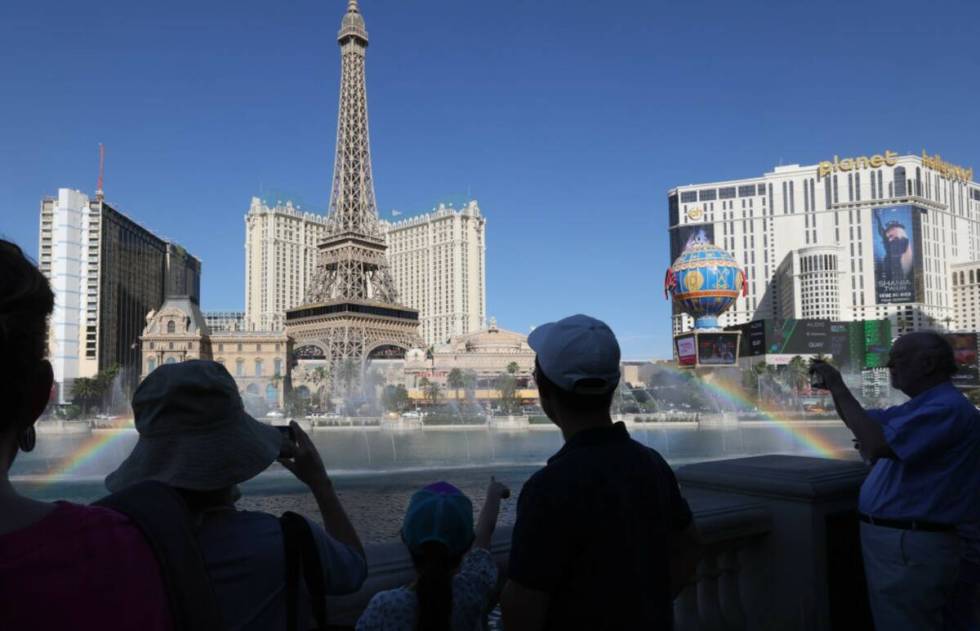Shattered heat records forecast dicey future for Sin City

The unrelenting Las Vegas heat is hard to ignore. While the Mojave Desert is hot and always has been, newly broken records aren’t likely to stand for long.
Inching three degrees past any temperature ever recorded at the National Weather Service’s airport station, Las Vegas set a new milestone on July 7 with an all-time high reading of 120 degrees. That milestone, which scientists predict will be surpassed again soon due to the effects of climate change, is a death-dealing one.
Dr. Joanne Leovy, a retired Las Vegas physician who founded Nevada Clinicians for Climate Action after noticing a spike in heat-related health issues among her patients, worries about the future of the everyday Las Vegan.
“This is exactly we expect with climate change: longer and more severe heat waves,” she said. “Here in Southern Nevada, we’re only at the tip of the iceberg.”
Previous Las Vegas Review-Journal reporting showed that the Clark County Coroner’s Office recorded 307 heat-related deaths in 2023, which the Associated Press said was the deadliest year to date in terms of heat across the U.S.
Heat illness doesn’t discriminate by age or fitness, Leovy said.
Abnormal, feverish desert temperatures
Las Vegas’ heat as of late is made five times more likely because of human-caused climate change, according to data from science communications firm Climate Central. Friday marked the seventh consecutive day above 115 degrees, the weather service said.
Jeff Goodell, author of “The Heat Will Kill You First,” a nonfiction book that sparked nationwide attention toward heat last year, told the Review-Journal the numbers coming out of Las Vegas aren’t surprising.
Climate Central considers Reno and Las Vegas among the fastest-warming cities in the country. They both suffer from urban heat island effect, data shows, where pavement and buildings trap heat.
Cities like Las Vegas need to “radically change” to adapt, Goodell said. New neighborhoods must be designed to be more heat resistant, and relief — in the form of cooling centers and air conditioning — needs to become more accessible.
That’s because extreme heat affects city residents unequally, he said. The burden is amplified for outdoor workers, sidewalk vendors and the homeless — all groups that need to be outside for their livelihoods.
“It’s a question of ‘uninhabitable for who?’” Goodell said. “Who do we really care about? What kind of equity will there be in a place like Vegas?”
In June, Reno and Las Vegas topped Climate Central’s list of temperature anomalies, meaning they both outpaced their historical temperatures of an average June more than any other cities.
While high air pressure is elevating heat in Las Vegas, Climate Central meteorologist Shel Winkley said much of the driving force behind extreme temperatures can be tied to an increase in carbon emissions that are warming the planet.
“This is a heat that’s been made more intense and exceptional because of climate change,” Winkley said. “It’s a compounding heat.”
Is Nevada taking heat seriously?
Republican Gov. Joe Lombardo has publicly said he believes in human-caused climate change.
However, he pulled Nevada out of a multi-state U.S. Climate Alliance last July and scrapped a statewide carbon emissions reduction plan put forth by his Democratic predecessor.
Lombardo’s spokeswoman, Elizabeth Ray, shared a letter in which Lombardo said his decision was based on his view that the alliance “conflicts with with Nevada’s energy policy objectives.” Lombardo’s version of a climate innovation plan will be released publicly in the next few weeks, she said, though Nevada Democrats have criticized how long that has taken.
Other heat-prone cities such as Phoenix and Miami have a designated heat officer who works on mitigation strategies like planting trees, building green spaces and helping design neighborhoods.
That’s not the case in Las Vegas.
Serving a similar function, though, is the Desert Research Institute’s Southern Nevada Heat Resilience Lab. It formed two years ago to solicit short- and long-term solutions to extreme heat.
Ariel Choinard, the lab’s coordinator, said the working group that meets after every extreme heat event has grown in size, with 75 representatives from groups including the Southern Nevada Water Authority and homeless outreach organizations.
The most visible local response to extreme heat has been the opening of cooling centers; their effectiveness is being studied by Choinard and her colleagues.
Heat is a systemic issue that’s tied to many others such as drought and health disparities, she said. It’s important for there to be a coordinated response involving local government and community leaders, which the lab is hoping to spearhead.
“Once you start pulling on this thread, you end up talking about everything,” Choinard said. “This is no small problem.”
Tom Albright, a UNR professor who serves as the interim state climatologist, said he’s heartened by efforts to address heat and the effects of climate change in Southern Nevada.
Just as Nevada has emerged as a leader in water conservation, Albright said he hopes it can catch up to other states in mitigating extreme heat.
“When we’re confronted with problems, we can create solutions that make the best of the situation,” he said of Nevada’s response to drought. “Similarly, with heat, this is only the beginning.”
Contact Alan at ahalaly@reviewjournal.com. Follow @AlanHalaly on X.